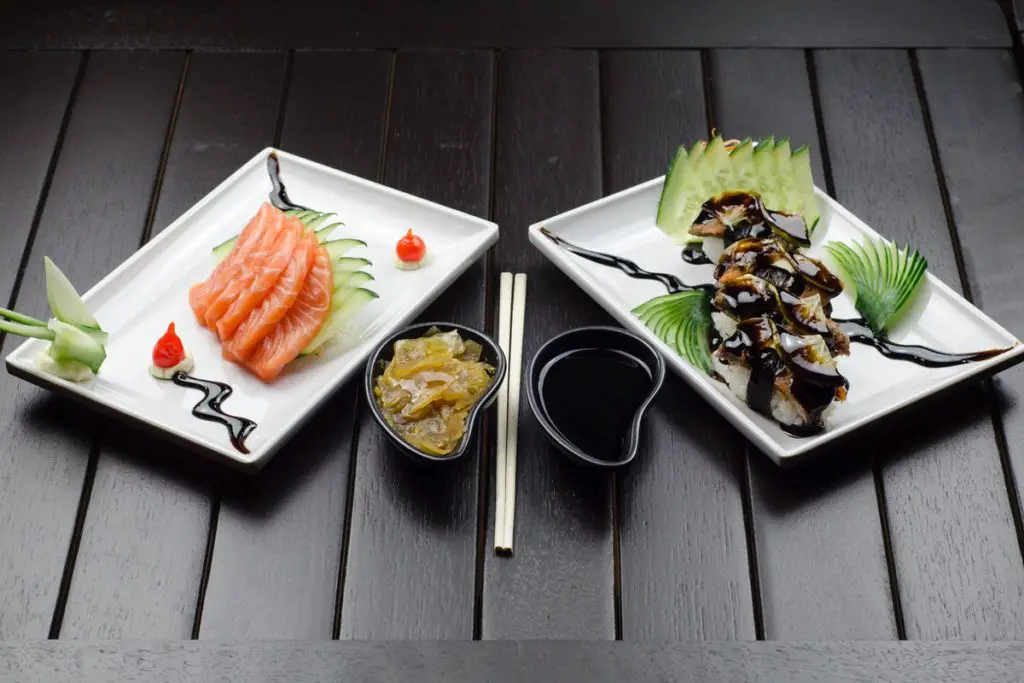For anyone who’s interested in Chinese cuisine, it’s essential that you know all about the wide variety of sauces you can use.
This is because the right sauce used in the correct dish can provide the perfect burst of flavor, color, and texture.
Hoisin sauce and oyster sauce are two of the most popular and tasty sauces you can add to traditional Chinese dishes, but what’s the difference between the two?

To provide the short and simple answer, hoisin sauce is significantly sweeter and suitable for vegans, whereas oyster sauce is non-vegetarian and provides a mild flavor of fish.
However, if you really want to excel in the kitchen with either hoisin sauce or oyster sauce, it’s important to learn the differences between the two in a greater amount of depth.
With this in mind, our guide will take a closer look at some of the key characteristics of each sauce, including everything you need to know about taste, texture, shelf life, and much more.
We’ll also look to answer a number of the frequently asked questions related to the two popular sauces.
A Brief Description Of Both Sauces
Before taking a more in-depth look at some of the main similarities and differences between hoisin sauce and oyster sauce, it’s useful to provide a brief explanation of both.
Hoisin Sauce
Hoisin sauce is made up mainly of fermented soybeans and is entirely vegan in nature. The sauce is incredibly popular in Chinese cuisines, as well as all over the world.
To make hoisin sauce, first the soybean is crushed into a paste with wheat flour.
There are a number of ingredients then involved in the production of the sauce, including oil, vinegar, salt, garlic, sweeteners, and much more.
As a result of the fermented soybeans, hoisin sauce often has an “Umami” taste, while the color and texture of the sauce is reddish-brown with a fairly thick consistency.
Today, people mainly use hoisin sauce in Cantonese cuisine.
Oyster Sauce
On the other hand, oyster sauce is made out of oyster extracts (hence the name).
It’s one of the most important sauces in Chinese cuisine, and like hoisin sauce, is popular all over the world, especially in Thai, Cantonese, and Vietnamese cuisine.
To make oyster sauce, the oyster extracts are first caramelized and then boiled down. Following this, other ingredients such as salt and sugar are added.
It’s also worth noting that some brands often add soy sauce and cornstarch to give the oyster sauce a slightly thicker consistency.
Unsurprisingly, oyster sauce doesn’t have an overpowering taste of fish.
Instead, the tasting notes are described as earthy, sweet, and slightly salty, while the sauce itself is dark brown-black with a thick consistency.
It’s worth keeping in mind that some of the cheaper brands of oyster sauce may taste and smell overwhelmingly fishy. This is why it’s recommended to opt for high-quality oyster sauce.
Differences
When taking a closer look at both hoisin and oyster sauce, there are several notable differences between the two. We’ll now look to explain some of these in greater depth.
Ingredients
One of the more obvious differences between hoisin sauce and oyster sauce is the ingredients that are used. Hoisin sauce is completely vegan, whereas oyster sauce is non-vegetarian.
Hoisin sauce contains a number of dairy-free and animal-free ingredients, including fermented soybean paste, sesame seeds, starch, spices, chili and garlic, water, and preservatives like vinegar, salt and sugar.
In contrast, oyster sauce is made up of animal products, containing ingredients like oyster extract, starch, preservatives, water, as well as extra thickeners and flavors.
It’s worth bearing in mind that the ingredients used for both hoisin sauce and oyster sauce can vary depending on the brand you’re using.
Therefore, it’s always a good idea to take a thorough look at the ingredients list on the back of a product before consuming it.
Smell
Considering the fact that both sauces contain different ingredients, it’s hardly surprising that hoisin sauce and oyster sauce smell different to one another.
Hoisin sauce is a little sweeter than oyster sauce, therefore the main odor profile is also sweet.
This sweet and fruity scent is mainly due to the fermentation of the soybeans and the presence of other ingredients.
If you come across a hoisin sauce which emits a strong, pungent, or sour odor, it’s best to avoid consuming it. This is because it’s likely that the sauce has become stale.
On the other hand, oyster sauce provides a mild odor of fish or seafood. It’s worth noting that it also has a slightly sweet and pungent scent due to the other ingredients used in the sauce.
Taste And Texture
Hoisin sauce and oyster sauce are sweet and salty in nature, while they both also provide a specific “Umami” flavor.
Despite this, there are a number of differences to take into account when it comes to taste and texture.
Firstly, hoisin sauce is often considered a richer version of an American-style barbecue sauce because of its sweeter profile and the addition of some saltiness and spiciness.
In terms of consistency, hoisin sauce is considerably thicker in texture, mainly due to the addition of starches and other thickeners during the production process.
Oyster sauce doesn’t provide quite as sweet a taste, instead offering a slight flavor of fish. It’s also less thick in comparison to hoisin sauce, despite the use of starches and thickeners.
Storage And Shelf Life
If you’re planning on buying some hoisin sauce, you can expect it to last for around three years if you don’t open the seal. This is reduced to 12-18 months once the seal has been opened.
It’s worth noting that this impressive shelf life is all dependent on proper storage.
Therefore, it’s essential you keep hoisin sauce refrigerated with the lid screwed on tightly at all times.
Without effective storage, there’s every chance that the sauce will become stale and develop mold.
The shelf life of oyster sauce isn’t quite as impressive as hoisin sauce. Once the seal of oyster sauce has been opened, you can expect it to last for anywhere between six months to a year.
After this, it’ll lose its freshness. If the seal hasn’t been opened, oyster sauce can last for around 18-24 months.
In terms of storage, oyster sauce should be kept refrigerated with a proper lid.
If the seal hasn’t been opened, oyster sauce can also be stored in a cool, dry place, so long as it’s far away from any heating appliances.
Nutrition
Hoisin sauce contains a considerable amount of sodium (roughly 400 mg per serving) due to the presence of salt.
The sauce is also packed with sugar, making it a bad choice for anyone trying to avoid high-sugar foods, while the protein and fat content is incredibly low.
Oyster sauce is similar in the sense that it’s low in nutrients. There’s also plenty of sodium in oyster sauce (490 mg per tablespoon) due to the preservatives used in the production.
Unlike hoisin sauce, oyster sauce doesn’t contain quite as much sugar, although the protein and fat content isn’t enough for a balanced, healthy diet.
So… Which Is Better?

As this guide has demonstrated, both hoisin sauce and oyster sauce have their own benefits. Therefore, deciding which is “best”, ultimately depends on your requirements.
Hoisin sauce is probably the best choice if you want a fully vegan option, a sauce that provides a sweet rather than salty flavor, and one which is perfect for using as a dip for duck pancakes, spring rolls, and much more.
On the other hand, oyster sauce is a better match if you’re looking for a slightly salty, fishy flavor, a sauce with a lower sugar content, and one which works well with stir-fry vegetables, beef, noodles, and so on.
Frequently Asked Questions
What’s The Best Use For Hoisin Sauce?
Hoisin sauce is widely used throughout China, meaning its flavor is pretty dominant in lots of Chinese and Cantonese cuisine.
The sauce is particularly great for adding some sweet flavor to dishes such as noodles and stir fry.
Another one of the popular uses of hoisin sauce is as a dip. Whether you’re snacking on spring rolls, dumplings, or duck pancakes, hoisin sauce makes the perfect accompaniment.
What’s The Best Use For Oyster Sauce?
Oyster sauce is often used in a similar sense to hoisin sauce, although it’s best in dishes where the overriding flavor isn’t quite as sweet.
Some of the most popular dishes which use oyster sauce include Chow Mein and Sichuan noodles.
Oyster sauce can also be used as an effective glaze, whether you’re looking to brush it over beef, mushrooms, or even vegetables.
What Are The Best Substitutes For Hoisin And Oyster Sauce?
While hoisin sauce and oyster sauce can be used interchangeably, there are plenty of suitable substitutes you can choose from. Listed below are four of the best options:
- Soy sauce – this sauce is much saltier than sweet, making it a good substitute for oyster sauce.
- Miso paste – if you want to achieve the same sweet and savory flavor of hoisin sauce, miso paste is an excellent choice.
- Fish sauce – this substitute provides a mild flavor of fish and saltiness which is ideal for replicating oyster sauce.
- BBQ sauce – if you haven’t got your heart set on an authentic and rich flavor, BBQ sauce can be used as a great alternative to hoisin sauce.
The Bottom Line
To conclude, both hoisin sauce and oyster sauce provide a unique flavor that’s enough to get anyone’s taste buds tingling.
However, choosing between the two can often be difficult with lots of different factors to take into account.
Hopefully, with the information in this guide, you’ll be in a better position to understand which of the two is the best choice for your individual requirements!
